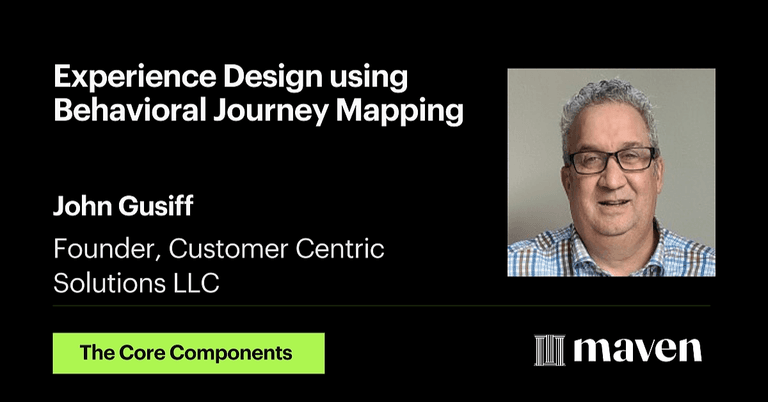Quantitative JTBD Methods for Smarter Product & Experience Decisions
JOHN GUSIFF
Managing Partner - Customer Centric LLC
DOMINIC RICCHETTI
Insights Architect, Consultant CX/UX/MR

Uncover. Quantify. Innovate. Transform Your Product and CX Strategy
🔍 Uncover. 📊 Quantify. 🚀 Innovate.
Transform Your Product Experience and Strategy with Jobs-to-Be-Done Research
Most teams stop at the customer interview. But understanding customer progress isn’t just about rich stories — it’s about translating that insight into an actionable, quantified strategy.
Gain the tools, methods, and confidence to drive smarter product decisions leveraging proven jobs-to-be-done quantitative research methods.
It will be case study-based course you'll get hands-on experience in the following:
🎯 Define your market (job performer + job=to-be-done) using the Market Definition Canvas
🔍 Identify the core job, related jobs, and emotional context
🛠️ Create a robust process map to reveal friction and opportunity across the customer journey
🎯 Pinpoint and validate the right target audience
📋 Design outcome-based surveys that quantify product and CX opportunities
📈 Run opportunity scoring to prioritize what matters most
🧠 Make strategic decisions based on actual customer progress — not opinions
We’ll leverage powerful frameworks and methods from Tony Ulwick and Jim Kalbach.
What you’ll learn
Learn Advanced JTBD quantitative methods that prioritize opportunity, guide product roadmaps, and shape exceptional customer experiences.
Clearly define your market, job performer, and job focus using the Market Definition Canvas.
Align teams around a shared understanding of who you're serving and what progress they’re trying to make.
Break down the job into steps, tasks, desired outcomes, and emotional/social dimensions.
Reveal friction, workarounds, and unmet needs that set the foundation for quantitative survey design.
Craft a rigorous survey—including screeners, job statements, and outcome metrics—to measure what truly matters to customers.
Collect statistically meaningful data that validates qualitative insights and removes guesswork.
Use tools like DisplayR to run opportunity scoring, segmentation, cross-tabs, and outcome-based prioritization.
Transform raw data into compelling visual insights your team can immediately act on.
Prioritize unmet needs and opportunities using quantitative scoring methods (e.g., satisfaction vs. importance).
Translate insights into a roadmap that aligns product, CX, and go-to-market around customer progress.
Use principal component analysis (PCA) to uncover latent need structures that inform segmentation, messaging, pricing, and product bundling.
Make key decisions by connecting outcome variance to strategy—revealing where differentiation, adoption & retention opportunities truly lie.
Who this course is for
Innovation Leaders seeking to identify underserved markets and high-impact opportunities that shape product and experience strategy.
Product managers looking to prioritize jobs/outcomes using quantitative customer needs data, not just gut instinct.
User and UX Researchers ready to move beyond interviews and turn JTBD insights into statistically valid, data-backed findings.
What's included
Live sessions
Learn directly from JOHN GUSIFF & DOMINIC RICCHETTI in a real-time, interactive format.
Lifetime access
Go back to course content and recordings whenever you need to.
Community of peers
Stay accountable and share insights with like-minded professionals.
Certificate of completion
Share your new skills with your employer or on LinkedIn.
Maven Guarantee
This course is backed by the Maven Guarantee. Students are eligible for a full refund up until the halfway point of the course.
Course syllabus
6 live sessions • 74 lessons • 10 projects
Week 1
Mar
23
Session 1: Job Theory and Frameworks
📚 Job Theory and Frameworks
💡 Types of Innovation
🎯 Our Focus: Product Innovation and Customer Experience
🧪 Our Case Study
🗺️ Using the Market Definition Canvas
🧩 Job Mapping (Job Steps, Activities, Outcomes)
Mar
25
Session 2: JTBD Survey Design and Execution
🧠 Foundations of JTBD Quantitative Surveys
📝 Screener and Quota Design
📐 Survey Structure and Design Best Practices
📋 Writing JTBD Outcome Statements
🎯 Target Audience & Sampling Strategy
🧪 Fielding the Survey and Data Collection
Survey and Analysis Tools
Intro to DisplayR
Week 2
Mar
30
Session 3: Opportunity Scoring (Product Experience)
🔧 Opportunity Scoring Fundamentals (Ulwick’s ODI Method)
📐 Structuring Your Survey for Scoring
🧮 Performing Opportunity Scoring
🎯 Prioritizing Opportunities
Apr
1
Session 4: Advanced Quantitative Techniques to Deepen JTBD Insights
📊 Using Summary Tables and Crosstabs to Explore Findings
Using Banners to Explore and Discover the Most Interesting Findings
Glossary of Survey Terms
Free resource

Experience Design using Behavioral Journey Mapping
Introduction to the Make it Toolkit for Behavioral Design
Making the Design Sprint process more human-centered by integrating the makeit toolkit into it.
Overview of the Five Laws of Behavior
The Five Laws of Behavior B=f(P,E), B=f(S1,S2), A->B->C, B=MAP, and B=f(I,E) to inform behavioral design.
Behavioral Journey Map vs. Traditional Journey Map
The core differences between a behavioral journey map and a traditional journey map (focus, design objective, etc.).
Core Components of a Behavioral Journey Map
The core components to a behavioral journey map (prompts, behavior, consequences, barriers, and opportunity points).
Schedule
Live sessions
4 hrs / week
Six LIVE cohort sessions across 3 Weeks; 2 sessions per week
Mon, Mar 23
5:00 PM—7:00 PM (UTC)
Wed, Mar 25
5:00 PM—7:00 PM (UTC)
Mon, Mar 30
5:00 PM—7:00 PM (UTC)
Projects
2 hrs / week
Hands-on assignments to apply learnings from Live cohort session.
Async content
1 hr / week
Articles and videos providing additional content around course topics.
Testimonials
- We utilized the methods taught in this course to better understand our most important customers - their emotional connection to the brand and its' products. To better tailor our marketing messages and understand different loyalty drivers.

Jacqueline Poriadjian
Former CMO, Canada Goose - We leveraged the jobs-to-be-done process to identify opportunities to improve our on-boarding experience, helping new Gympass members find the right plan, gym or studio for themselves along with getting started on their wellness journey.

Minh Tran
Senior Director CX, Wellhub - John has demystified key concepts of 'jobs to be done' and behavioural science, showing how they can be integrated to enhance product design and marketing. As a product designer, I gained valuable insights and practical tips to enhance my design practice - especially in how to spot opportunities in research interviews. I would recommend the course.

Dean Donnovan
Strategic Produce and Service Designer, Callaghan Innovation - John is a great course instructor. Not only are his presentations high quality, he also gives illustrative B2C + B2B examples from his rich consulting experience. He nudges you to keep doing the well-prepared homework assignments even on busy days, and he gives you feedback offline and space to discuss solutions and questions in the next live class

Pete Savnigny
Senior UX Researcher - I would call this more of a workshop vs. course because you get a lot of practical hands on time to test the theoretical knowledge (well-presented)—all with a ton of support by John, who has decades of real-world experience and is a great instructor. Highly recommend!

Sharon Rylander
UX Resarch and Strategy, for Startups - The JTBD Frameworks and Methods course was chock full of great information on the Top 3 JTBD models, and John really understands them and explains their differences and strengths of each. Highly recommend his courses.

Susan Mercer
Director of UX Research, ex-Viator/Tripadvisor
Frequently asked questions
$1,250
USD

